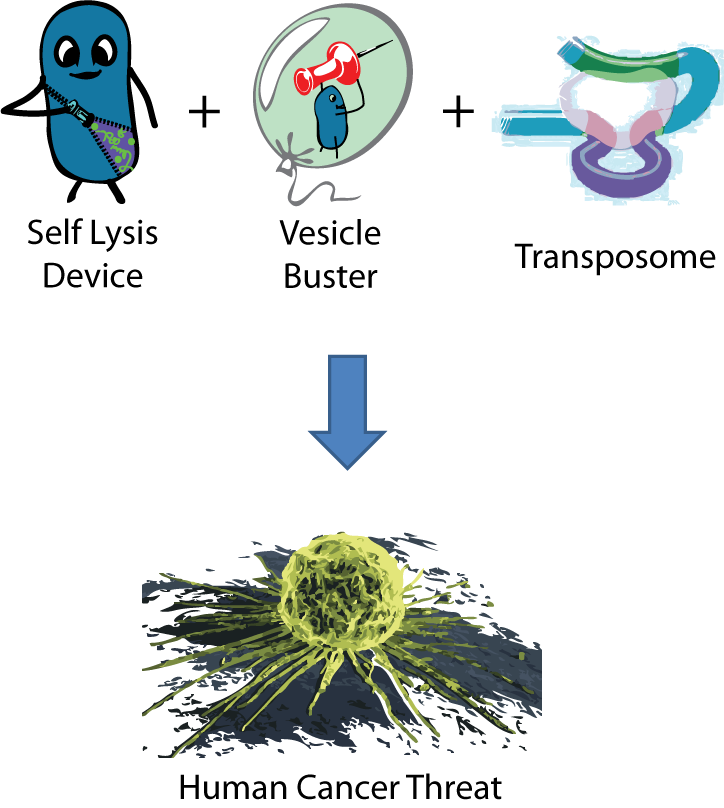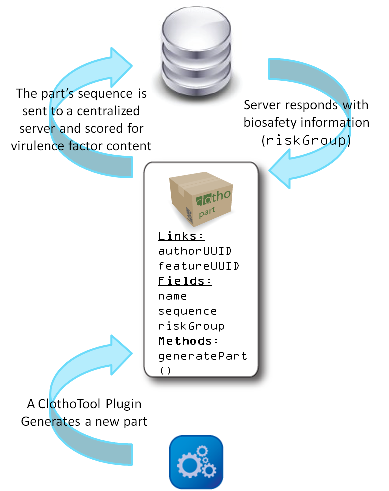Team:Berkeley/Human Practices
From 2010.igem.org
(→Working Towards A Solution) |
JCAnderson (Talk | contribs) |
||
| Line 11: | Line 11: | ||
<br> | <br> | ||
=='''Current Biosafety Standards'''== | =='''Current Biosafety Standards'''== | ||
| - | Biosafety is undoubtedly one of the highest priorities of any synthetic biology institution. Unforeseen consequences of genetic manipulation can be disastrous, especially when dealing with pathogenic organisms or virulence factors. The NIH and CDC have developed a standard of | + | Biosafety is undoubtedly one of the highest priorities of any synthetic biology institution. Unforeseen consequences of genetic manipulation can be disastrous, especially when dealing with pathogenic organisms or virulence factors. The NIH and CDC have developed a standard of risk groups (RG) to rate the risk associated with different biological agents and genetic parts. They are summarized here: |
| - | *'' | + | *''RG 1''- Well characterized parts and organisms that are not consistently pathogenic to healthy adults. |
| - | *'' | + | *''RG 2''- Associated with mild human diseases, but do not readily spread through aerosols |
| - | *'' | + | *''RG 3''- Associated with deadly or severe human diseases that we have vaccines or treatments for. |
| - | *'' | + | *''RG 4''- Associated with deadly, aerosol-spread diseases that have no known vaccine or treatment |
| - | The current system of rating synthetic biological | + | The current system of rating synthetic biological sysytems simply chooses the highest risk group of all the parts within the chassis and the risk group of the chassis. This is equivalent to describing the organism as having a list of devices with risk groups determined from their component parts. Though the risk can be downgraded by a biosafety officer, this simple analysis is the technical standard for deciphering the risk of genetically engineered organisms today. For example, our Vesicle-Buster parts this year contain virulence factor (RG2) coding sequences from the pathogen ''Clostridium perfringens'', making the entire device RG2. Furthermore, any organism created from those parts would be considered RG2 or heigher. Because of this risk, in consultation with our biosafety officer, it was decided that these materials should not be entered into the Registry. However, the materials and sequences will be made available to labs showing evidence of institutional biosafety authorization.<br><br> |
| + | |||
| + | In addition, there is a list of "select agents" composed of specific organisms, specific proteins, and specific chemicals that carry the potential to be used as bioweapons. Since any organism composed of parts encoding proteins or biosynthesizing chemicals from the select agent list would contain the select agent, the resulting organisms would necessarily also be a select agent. So, in effect, a similar logic to describing the risk associated with a synthetic composition can be used to implement both the select agent and risk group frameworks. | ||
=='''Shortcomings of the System'''== | =='''Shortcomings of the System'''== | ||
| Line 23: | Line 25: | ||
<br> | <br> | ||
<br> | <br> | ||
| - | We created an engineered organism that used a Self Lysis device (made up of '' | + | We created an engineered organism that used a Self Lysis device (made up of ''RG''1 parts) to release its contents inside vesicles and a Vesicle Buster device (which contains ''RG''2 parts) to break out of any cholesterol-based vesicle membrane. This device has been shown to function in mammalian cells. Lastly, we constructed a number of transposase devices (all ''RG''1) to potentially integrate transposons into our target's DNA. We designed this combination of parts to deliver transposases and DNA to a lower metazoan in an attempt to genetically modify it. Alarmingly, if a bacteria containing this combination of parts entered the body and was exposed to a macrophage, it could quite possibly break into a human cell and deliver its payload, genetically modifying the human DNA. A transposon insertion in the wrong place in the DNA could be oncogenic. Fortunately, this risk was realized long before any parts were built this summer, and the necessary precautions were taken - our lysis device was put under inducible control to prevent undesired delivery, and all organisms that would combine transposon devices and payload delivery would employ strains deficient in iron acquisition. This well-established approach to attenuation reduces the risk of uncontrolled growth in biological fluids.<br><br> |
[[image:BiosafetyThreat.png|500px|center|frame]]<br><br> | [[image:BiosafetyThreat.png|500px|center|frame]]<br><br> | ||
The discovery of this potential risk illuminated that the current biosafety rating system cannot identify potential threats from the combination of individually innocuous genetic parts. This is disconcerting, considering how the culture of synthetic biology is moving towards fast-paced construction and exchange of complex genetic parts. This could be dangerous to the scientists who are ignorant of the virulence they are synthesizing. The failure of government standards to recognize engineered threats also means that researchers could avoid regulations and restrictions that should reasonably required.<br><br> | The discovery of this potential risk illuminated that the current biosafety rating system cannot identify potential threats from the combination of individually innocuous genetic parts. This is disconcerting, considering how the culture of synthetic biology is moving towards fast-paced construction and exchange of complex genetic parts. This could be dangerous to the scientists who are ignorant of the virulence they are synthesizing. The failure of government standards to recognize engineered threats also means that researchers could avoid regulations and restrictions that should reasonably required.<br><br> | ||
| Line 30: | Line 32: | ||
{| cellpadding="0" cellspacing="25" | {| cellpadding="0" cellspacing="25" | ||
|[[image:ClothoBiosafety.jpg]] | |[[image:ClothoBiosafety.jpg]] | ||
| - | || Clotho implements the current biosafety standards as outlined by the NIH and the CDC. Whenever a new part is instantiated, Clotho BLAST's its sequence against a databank of known virulence factors and | + | || Clotho implements the current biosafety standards as outlined by the NIH and the CDC. Whenever a new part is instantiated, Clotho BLAST's its sequence against a databank of known virulence factors and pathogens and returns the RG number of the highest match. This framework ensures that every part in Clotho has a RG value associated with it. In addition, when composite parts are made by joining basic parts, the composite part is also assigned a BSL number. Finally, all strains in Clotho have a risk group. When composing "composite strains" from "basic strains" and a list of plasmids, the resulting strain has the highest risk group of all its component plasmids. In this way, risk groups are recursively passed through the acts of composition to help guarantee that the inclusion of some virulence factor at an earlier stage of development is not overlooked in future stages. A significant aspect of this feature is that the Clotho API enforces this check. Whenever any software tool makes a genetic Part object, Clotho checks it before it is saved to the database. |
|} | |} | ||
Revision as of 20:02, 27 October 2010
- Home
- Project
- Parts
- Self-Lysis
- Vesicle-Buster
- Payload
- [http://partsregistry.org/cgi/partsdb/pgroup.cgi?pgroup=iGEM2010&group=Berkeley Parts Submitted]
- Results
- Judging
- Clotho
- Human Practices
- Team Resources
- Who We Are
- Notebooks:
- [http://www.openwetware.org/wiki/Berk2010-Daniela Daniela's Notebook]
- [http://www.openwetware.org/wiki/Berk2010-Christoph Christoph's Notebook]
- [http://www.openwetware.org/wiki/Berk2010-Amy Amy's Notebook]
- [http://www.openwetware.org/wiki/Berk2010-Tahoura Tahoura's Notebook]
- [http://www.openwetware.org/wiki/Berk2010-Conor Conor's Notebook]
Human Practices: Rethinking Biosafety Standards
Current Biosafety Standards
Biosafety is undoubtedly one of the highest priorities of any synthetic biology institution. Unforeseen consequences of genetic manipulation can be disastrous, especially when dealing with pathogenic organisms or virulence factors. The NIH and CDC have developed a standard of risk groups (RG) to rate the risk associated with different biological agents and genetic parts. They are summarized here:
- RG 1- Well characterized parts and organisms that are not consistently pathogenic to healthy adults.
- RG 2- Associated with mild human diseases, but do not readily spread through aerosols
- RG 3- Associated with deadly or severe human diseases that we have vaccines or treatments for.
- RG 4- Associated with deadly, aerosol-spread diseases that have no known vaccine or treatment
The current system of rating synthetic biological sysytems simply chooses the highest risk group of all the parts within the chassis and the risk group of the chassis. This is equivalent to describing the organism as having a list of devices with risk groups determined from their component parts. Though the risk can be downgraded by a biosafety officer, this simple analysis is the technical standard for deciphering the risk of genetically engineered organisms today. For example, our Vesicle-Buster parts this year contain virulence factor (RG2) coding sequences from the pathogen Clostridium perfringens, making the entire device RG2. Furthermore, any organism created from those parts would be considered RG2 or heigher. Because of this risk, in consultation with our biosafety officer, it was decided that these materials should not be entered into the Registry. However, the materials and sequences will be made available to labs showing evidence of institutional biosafety authorization.
In addition, there is a list of "select agents" composed of specific organisms, specific proteins, and specific chemicals that carry the potential to be used as bioweapons. Since any organism composed of parts encoding proteins or biosynthesizing chemicals from the select agent list would contain the select agent, the resulting organisms would necessarily also be a select agent. So, in effect, a similar logic to describing the risk associated with a synthetic composition can be used to implement both the select agent and risk group frameworks.
Shortcomings of the System
As synthetic biology becomes more sophisticated and genes from various organisms are combined to make increasingly complex devices, unexpectedly dangerous constructs can be generated using seemingly innocent parts. During the design phase of our project, we discovered a combination of relatively innocuous parts that had the potential, in combination, to be hazardous.
We created an engineered organism that used a Self Lysis device (made up of RG1 parts) to release its contents inside vesicles and a Vesicle Buster device (which contains RG2 parts) to break out of any cholesterol-based vesicle membrane. This device has been shown to function in mammalian cells. Lastly, we constructed a number of transposase devices (all RG1) to potentially integrate transposons into our target's DNA. We designed this combination of parts to deliver transposases and DNA to a lower metazoan in an attempt to genetically modify it. Alarmingly, if a bacteria containing this combination of parts entered the body and was exposed to a macrophage, it could quite possibly break into a human cell and deliver its payload, genetically modifying the human DNA. A transposon insertion in the wrong place in the DNA could be oncogenic. Fortunately, this risk was realized long before any parts were built this summer, and the necessary precautions were taken - our lysis device was put under inducible control to prevent undesired delivery, and all organisms that would combine transposon devices and payload delivery would employ strains deficient in iron acquisition. This well-established approach to attenuation reduces the risk of uncontrolled growth in biological fluids.
The discovery of this potential risk illuminated that the current biosafety rating system cannot identify potential threats from the combination of individually innocuous genetic parts. This is disconcerting, considering how the culture of synthetic biology is moving towards fast-paced construction and exchange of complex genetic parts. This could be dangerous to the scientists who are ignorant of the virulence they are synthesizing. The failure of government standards to recognize engineered threats also means that researchers could avoid regulations and restrictions that should reasonably required.
 "
"


